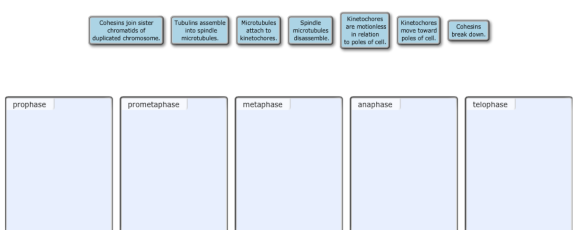Question
In: Biology
Mitosis unfolds through a sequence of stages marked by specific events in the cell.
Mitosis unfolds through a sequence of stages marked by specific events in the cell. The structural changes in the cell are about by a series of tightly coordinated underlying mechanisms.
Sort each process into the appropriate bin to indicate the stage of mitosis in which it occurs. If a process occurs in more than one stage, sort it to the stage when it first occurs.
- Cohesins join sister chromatids of duplicated chromosome.
- Tubulins assemble into spindle microtubules.
- Microtubules attach to kinetochores.
- Spindle microtubules disassemble.
- Kinetochores are motionless in relation to poles of cell.
- Kinetochores move toward poles of cell.

Solutions
Expert Solution
Prophase:
-Tubulins assemble into spindle microtubules
-Cohesins join sister chromatids of duplicated chromosomes
Prometaphase:
-Microtubules attach to kinetochores
Metaphase:
-Kinetochores are motionless in relation to cell poles
Anaphase:
-Kinetochores move toward poles of the cells
-Cohesins break down
Telophase:
-Spindle microtubules disassemble
Related Solutions
4. Discuss mitosis: Name all the stages of mitosis. Describe the main events that happen during...
Germ cell proliferation through mitosis: in males, this occurs __
What are the stages of mitosis
a. Compare the process of mitosis with the process of meiosis. Describe major cell cycle events....
let's imagine a diploid plant cell. a) draw the five stages of mitosis and meiosis assuming...
The stages of mitosis were originally defined by cellular features observable through a light microscope.
1- Write a comparison of the stages of meiosis to the stages of mitosis. Which stages...
Cell cycle: Explain the function of mitosis. What major events occur during each of the four...
5. Draw a cell with three chromosomes as it moves through mitosis and cytokinesis. 6. Draw...
1. Draw a cell with three chromosomes as it moves through mitosis and cytokinesis. 2. Draw...
- The world post Covid 19 has created the concept of social distancing which will impact on...
- Convert into pseudo-code for below code =============================================== class Main { public static void main(String args[])...
- If the density of the universe great than a critical value, then it might continue expanding...
- A 16.4-kg block rests on a horizontal table and is attached to one end of a...
- Freud’s theory of defense mechanisms has had a profound impact on the methods used by therapist,...
- discuss what a disclaimer is, when is it is issued, and how it would affect the...
- Explain why 1 additional net ATP is produced when the beginning substrate is glycogen compared to...
 Dr. OWL answered 4 years ago
Dr. OWL answered 4 years ago